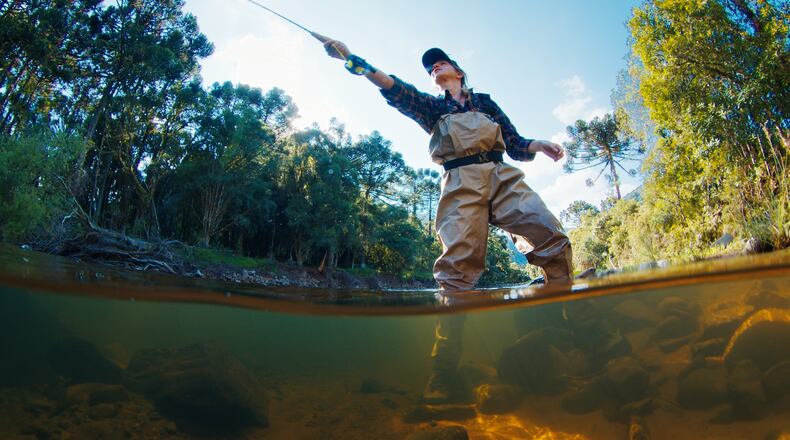That’s why wet wading — wading without boots or waders that keep your lower extremities dry — is one of my favorite ways to fish for a number of reasons.
One, it’s simple. You don’t need much gear, and less is actually better. An ultra-light or lightweight spinning rod, a simple way to carry your absolute top handful of lures, pliers and clippers and if you’re inclined, some water shoes (or shoes that you don’t care much about) and some dry ones for the ride home.
Add some bug spray, polarized sunglasses, sun protection and you’re set.
Second, it creates better casting and presentation angles. Stepping off the bank and into the water lets you make that parallel cast to cattails in a farm pond or into that undercut bank of a stream. Both of these situations are where predator fish are looking for and expecting their next meal. Another benefit is that if you get snagged, you’re already in the water, so it’s no big deal to get lures lose.
Third, the water around your knees and mud between your toes further connect you with the environment in a unique way. You can feel it. Your perspective goes from that of an observer on the bank to a predator (whether you keep the fish or not) in a different world. Even more than a boat or kayak, getting away from the shore on your own two feet makes a big difference.
The right lure
When packing the bag, I’d bring the light tackle lures you have the most confidence in, your go-to baits. I can’t say that I pack, because I have a bag specifically for light tackle that’s always ready to go. It’s got options for everything from topwater to some floating crankbaits that get down to maybe six feet, some inline spinners, and some plastics and jigs. But truth be told, once I hit the water and make a decision, I generally stick with it. I don’t spend a lot of time changing lures unless something visibly changes. I’ll vary the retrieve and change angles but keep plugging along. That is, unless a companion is really outfishing me. If it’s working for them to the extreme, there’s no sense fighting it.
Water levels and clarity
One thing about August water levels in Ohio is that they’re typically low, especially in streams. In some slower, rocky streams, this can lead to crystal clear water. In situations like that, combined with minimal pressure, you might find yourself sight casting to a variety of fish if you’re lucky and careful. That’s hard to beat for fun. You probably won’t catch a new state record that way, but it’s top of the list for fun.
You don’t have to cast a line
As a teenager, wet wading after soccer practice to bow shoot carp was a blast. And if you’re not the angling type, wet wading is just fun way to connect with your environment and look for other creatures. From crayfish to darters to hellagrammites, being in the water really does change your perspective and can help beat the heat of late summer days.
Notes about the ground under the water
While the flowing water above ground in navigable streams is considered “public good,” the solid ground below can be subject to private ownership. Know where you are. Get written permission if you’re on private ground. If you’re on public land or in a park, follow all signs and regulations. You’ll also likely need a license, which you should have anyway. A wading staff or even a stick is useful, especially if you can’t see your feet, to feel ahead for your next step and help keep your balance. A life jacket any time you’re in flowing water is never a bad idea.
The simplicity and natural connection of wet wading is its appeal. I hope you’re able to visit one of our local waterways and get your feet wet.
Devin Meister is a local outdoors and wildlife enthusiast and has a blog called “Average Guy Outdoors.” He is an Ohio University graduate. Reach him at meister.devin@gmail.com.
About the Author

